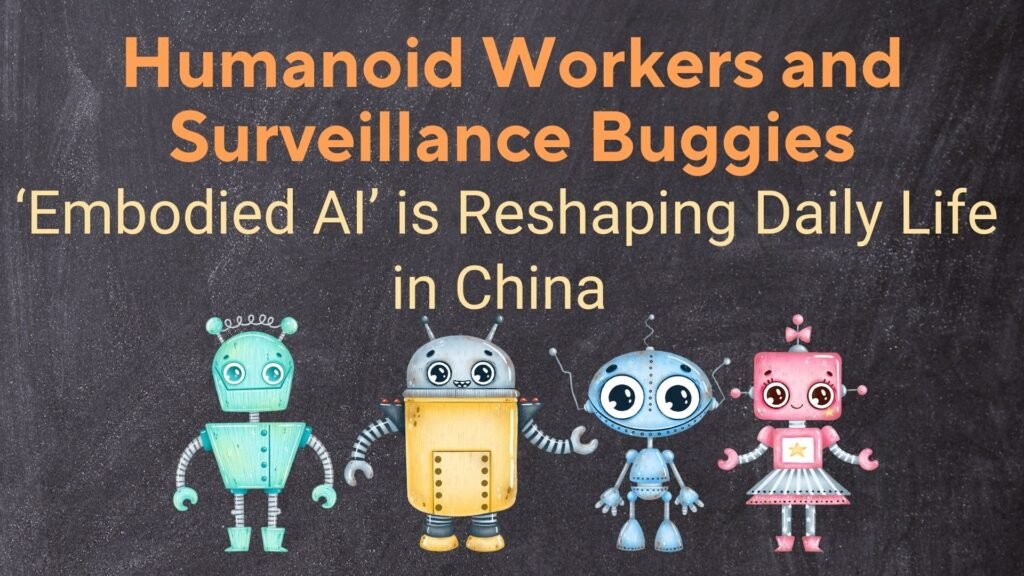In a world where artificial intelligence has increasingly moved from screens to streets, China is leading the charge into a new era of embodied AI—a blend of robotics, machine learning, and physical interaction revolutionizing how societies function. With humanoid robots becoming part of everyday life, from factory floors to shopping malls, and smart buggies patrolling public areas, the distinction between humans and machines is blurring faster than ever.
Welcome to the age where robotics and humanoids are not science fiction, but daily reality.

What Is Embodied AI?
Embodied AI refers to artificial intelligence systems that have a physical form—typically robots—that can interact with the physical world. Unlike virtual assistants that live in your phone or laptop, these systems have bodies, eyes (sensors), hands (actuators), and sometimes even faces. The integration of AI with robotic bodies is unlocking a new realm of possibilities in sectors like manufacturing, retail, security, elder care, and logistics.
China has become a global hub for this innovation, not just adopting but actively deploying AI-powered humanoid workers and surveillance machines across its cities.
Humanoid Robots: The New Face of Labor in China
China’s aggressive push toward automation is no secret. With an aging population and rising labor costs, the country is turning to humanoid robots as a sustainable solution for its economic future.
Humanoid robots—machines designed to resemble and mimic human behavior—are now seen in public spaces like airports, hospitals, and government offices. These robots are equipped with AI software, speech recognition, facial recognition, and emotion-detection technologies. They can speak multiple languages, offer customer service, provide directions, and even detect suspicious behavior.
The Pepper Robot: China’s Friendly Greeter
One of the most popular examples of a humanoid robot in China is the Pepper robot, developed by SoftBank Robotics. Standing at about 4 feet tall with a tablet on its chest, Pepper is designed to read emotions and engage in natural conversation.
In Chinese shopping malls and banks, Pepper robot greets customers, answers questions, and even entertains kids with dance routines and trivia. Its childlike appearance and human-like interactions have made it a favorite among businesses that want to offer a futuristic yet friendly user experience.
Surveillance Buggies: Security Gets Smarter
While humanoid robots focus on assistance and interaction, China’s cities are also filled with AI-powered surveillance buggies. These autonomous vehicles patrol neighborhoods, business parks, and public squares. Equipped with 360-degree cameras, facial recognition software, and AI-based anomaly detection, these buggies can detect criminal behavior, track missing persons, and alert human law enforcement in real-time.
The integration of these surveillance buggies is part of China’s larger plan to build “smart cities” where every element of urban life—from traffic to trash collection—is managed by intelligent systems.
Optimus Robot: Tesla’s Humanoid Enters the Scene
The race for advanced humanoid robots isn’t just limited to Chinese companies. Global players are entering the market too, with Elon Musk’s Optimus robot (developed by Tesla) capturing significant attention worldwide. While the Optimus robot is still in its early stages, its intended use—performing repetitive and dangerous tasks in factories—aligns with China’s interest in automated labor.
Though not yet mass-deployed in China, the Optimus robot represents the next phase of robotics and humanoids—machines that are not only intelligent but physically capable of performing high-level tasks. Chinese tech companies are already exploring similar models, with a few showcasing rival prototypes that may soon be mass-produced and exported.
Industries Transformed by Humanoid Robots in China
1. Manufacturing
In factories, humanoid robots are performing tasks like assembly, quality control, and welding. With the precision and efficiency that only machines can offer, they reduce human error and increase productivity.
2. Healthcare
Hospitals are using humanoid robots for everything from patient check-ins to transporting medical supplies. Their ability to work tirelessly without fatigue makes them ideal assistants in high-pressure environments.
3. Education
Robots like Pepper are being deployed in classrooms as teaching aids. They can speak in multiple languages, answer student queries, and even help in special education settings.
4. Hospitality and Retail
From concierge services to order-taking in restaurants, humanoid robots are improving customer experience while reducing the dependency on human staff. In many Chinese hotels, robots handle room service, check-ins, and even room cleaning.
Public Response: Fascination and Fear
China’s general public has largely embraced the shift, viewing humanoid robots as a symbol of progress. Kids wave at them. Adults take selfies. Elderly citizens find comfort in their polite and predictable behavior.
However, concerns do exist. Privacy advocates worry about the mass surveillance capabilities embedded in many AI systems. The presence of robots with facial recognition software in public spaces has raised ethical questions, particularly around data usage and state control.
Moreover, there’s an ongoing debate about job displacement. As AI takes over routine tasks, what happens to the human workforce? While some argue that new roles will emerge, others see a future where large swaths of the population could be left behind.
The Road Ahead: Collaboration Over Replacement
Despite concerns, the integration of humanoid and surveillance robots in China is set to accelerate. Government policies are supporting AI research, and companies are heavily investing in hardware and software innovation.
The future likely lies not in complete replacement but in collaboration between humans and machines. Robots will take over tasks that are dangerous, boring, or physically exhausting, while humans will focus on creative, emotional, and strategic work. The synergy between the two could redefine productivity and quality of life.
The rise of humanoid robots and surveillance technologies in China reflects a seismic shift in how we view labor, safety, and interaction. As embodied AI becomes more integrated into everyday life, it’s clear that robotics and humanoids are no longer the future—they’re the now.
Whether it’s a Pepper robot greeting you at a shopping mall or an Optimus robot handling warehouse logistics, the fusion of AI and robotics is reshaping the Chinese experience—and soon, perhaps, the world’s.
One thing is certain: the age of the humanoid has arrived, and it’s changing everything.



